

Updated 07/28/2021
Hop Butcher for the World has been an absolute hit on the Chicago beer scene in the last few years. Their beers' hoppy aroma, incredible mouthfeel, an orange juice-like appearance and flavors similar to that of fruit juice or pina colada are some of the characteristics that I had the pleasure of enjoying.
Their beer character and juiciness is something I saw as a homebrewing challenge ever since I started brewing. So after almost 2 years of brewing IPA's, I decided that it was a time for me to replicate this masterpiece of a beer.
Why Double Grid? It's a personal favorite, plus who doesn't like a solid Citra/Mosaic beer. To me, most of their Double NEIPA's seem like they use a similar recipe and switch out the hops.
In my initial research, I had stumbled upon a HomebrewTalk thread where a very observant fellow homebrewer found a few Instagram and Vimeo resources that helped him identify at least some of the ingredients.
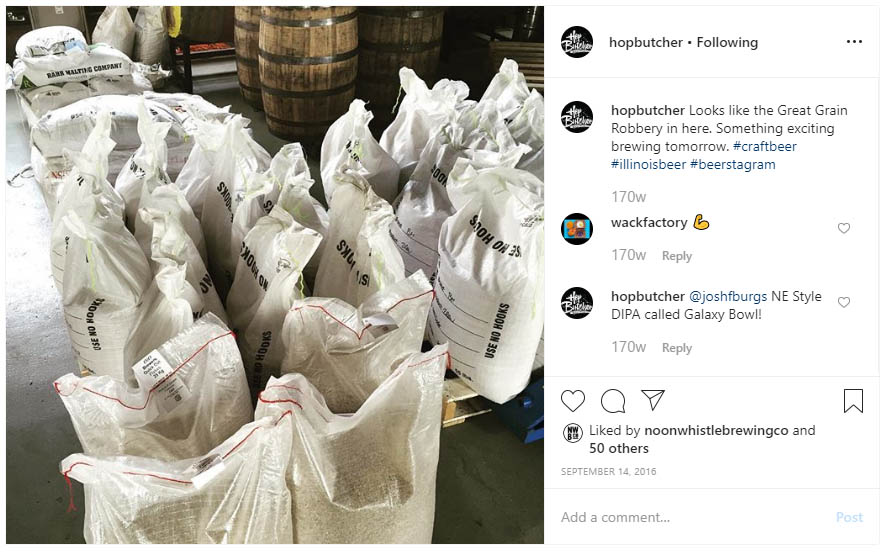 16 sacks of 2-row, 4 sacks of flaked oats, and something else in the background
16 sacks of 2-row, 4 sacks of flaked oats, and something else in the backgroundBut it's not as simple as 80% 2-row and 20% Oats. In Craft Beer & Brewing's podcast Hop Butcher dudes mention using 55-60% 2-row, and then equal parts Flaked Oats, Malted Oats, White Wheat with some Carafoam added. These definitely make sense to make up for the orange juice-like appearance and a final gravity of over 1.020.
The yeast used in HB's Vimeo upload was Imperial A24 Dry Hop. This isn't widely available in Chicagoland, but I have really been wanting to try this yeast for some time, so it was time to order it online. While making a yeast starter for A24, this yeast has serious Hop Butcher aroma, we have a winner.
Original Gravity and Final Gravity was the last question that remained. I have previously measured a few Hop Butcher beers using my hydrometer and the results were usually in the 1.020 - 1.028 FG. Crazy, right? My grist, even if I did go 10% Carafoam, only gets me to about 1.018 at 150F mash temp. To get to a gravity that high, we'd need to raise the mash temperature to 160F or use lactose.
This beer got 3rd place in a Midwinter Brew Competition, but I learned a few important lessons.
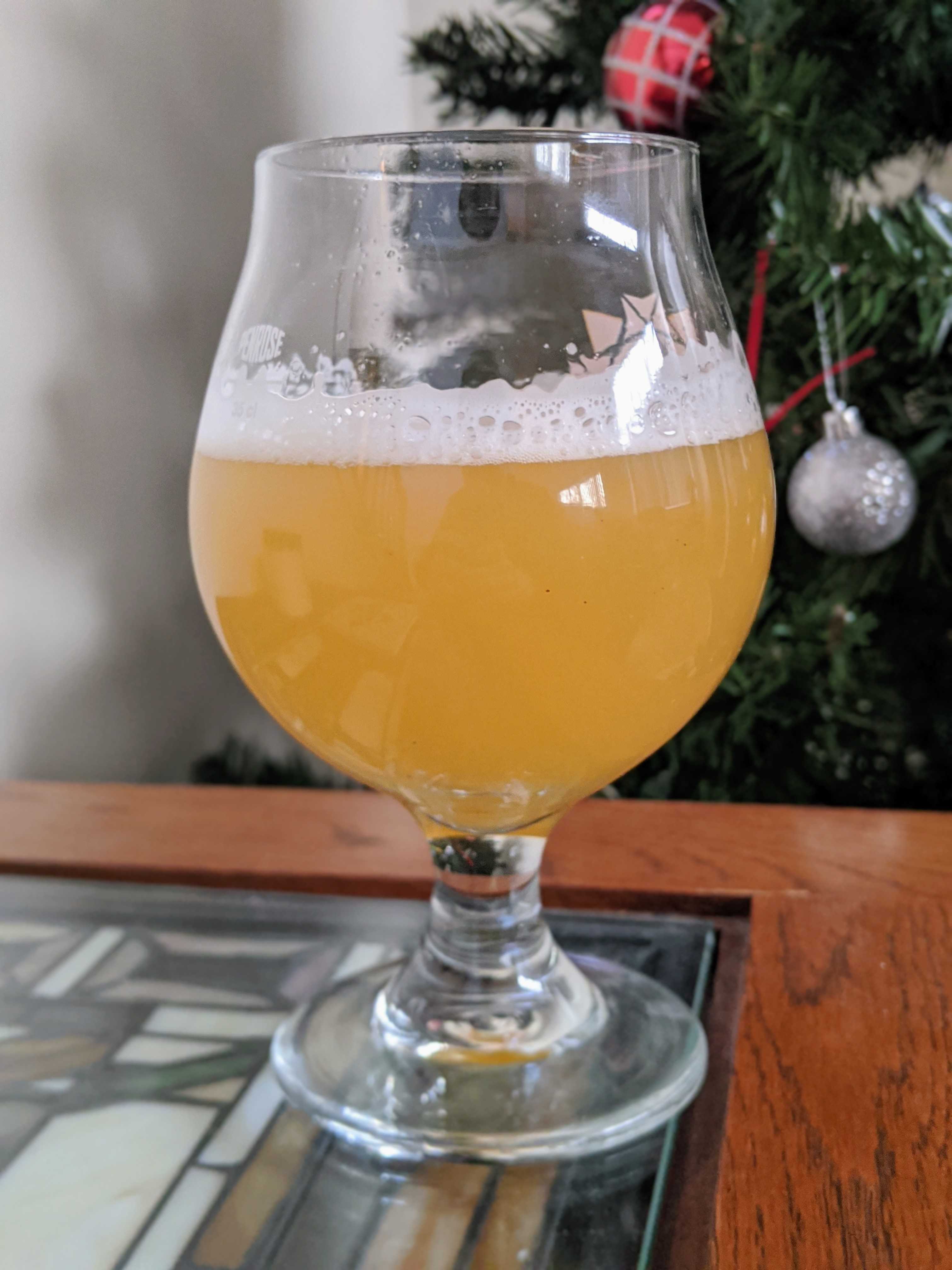 First Hop Butcher Clone attempt. Nice color, but not as opaque as Hop Butcher. Changing the grist should have a positive effect.
First Hop Butcher Clone attempt. Nice color, but not as opaque as Hop Butcher. Changing the grist should have a positive effect.Having now listened to the CB&B podcast, I have a better idea of the grist, I now know to mash at 155F and have a more reliable hop schedule. Time to brew my own Hop Butcher clone into reality!
OG: 1.081, FG: 1.025
56% Rahr Pale 2-row
13% Flaked Oats
13% Malted Oats
13% White Wheat
5% Briess Carafoam
1.5 oz each Citra and Mosaic pellets (Whirlpool @ 160F - 30 min, )
4.0 oz each Citra and Mosaic pellets (Dry Hop Day 9, 2oz/gallon total dry hop)
Started brewday by treating Chicago tap water with 2ml of Lactic acid, 4g of CaCl and 1g of Gypsum.
| Calcium | Magnesium | Sodium | Chloride | Sulfate | pH | |
| ppm | 141 | 6 | 0 | 198 | 96 | 5.36 |
Water ready, pH measured and the grains are ready to go in. I mashed in at 155F for 60 min.
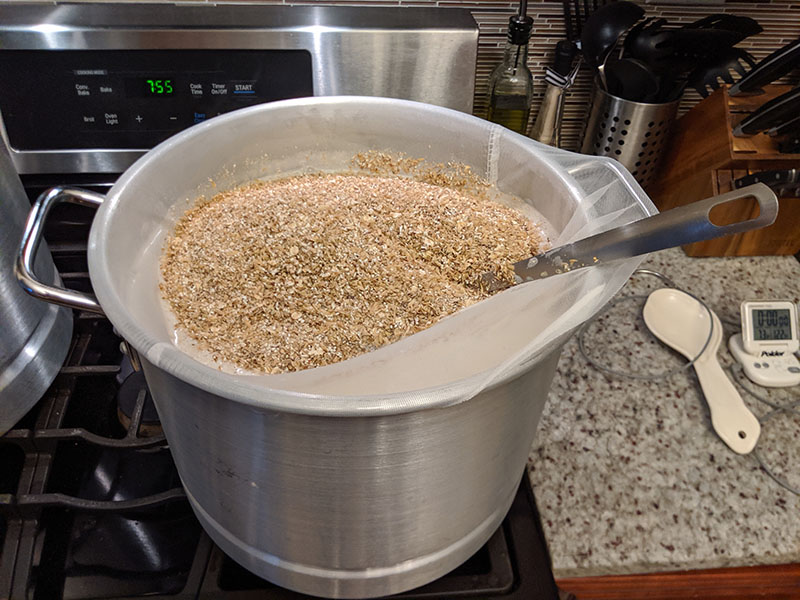 Grains in to mash at 155F for 60 min
Grains in to mash at 155F for 60 minAfter the mash was complete, it was time to start the boil. I didn't add any boil hops per Podcast.
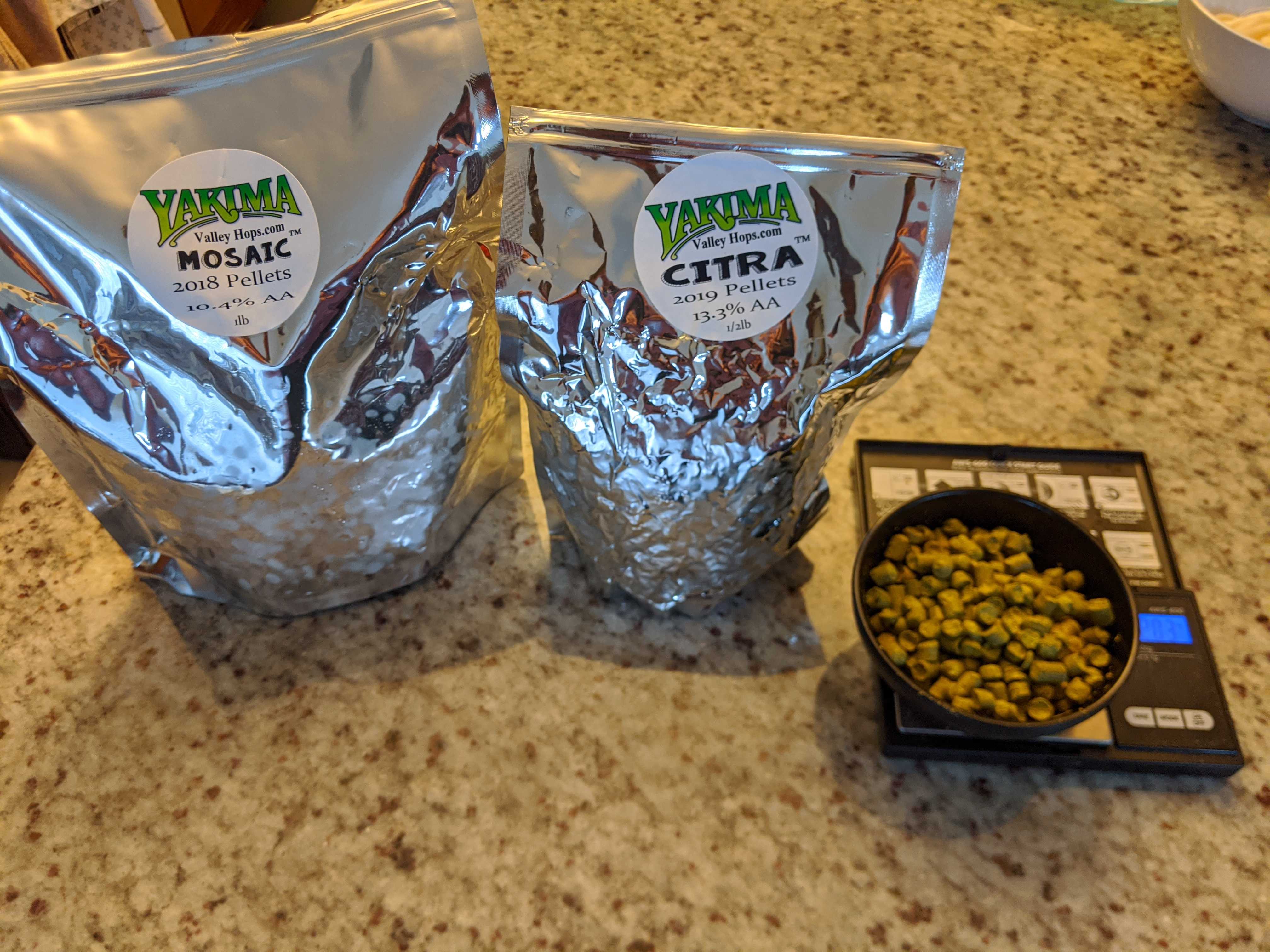 Whirlpool hop additions
Whirlpool hop additions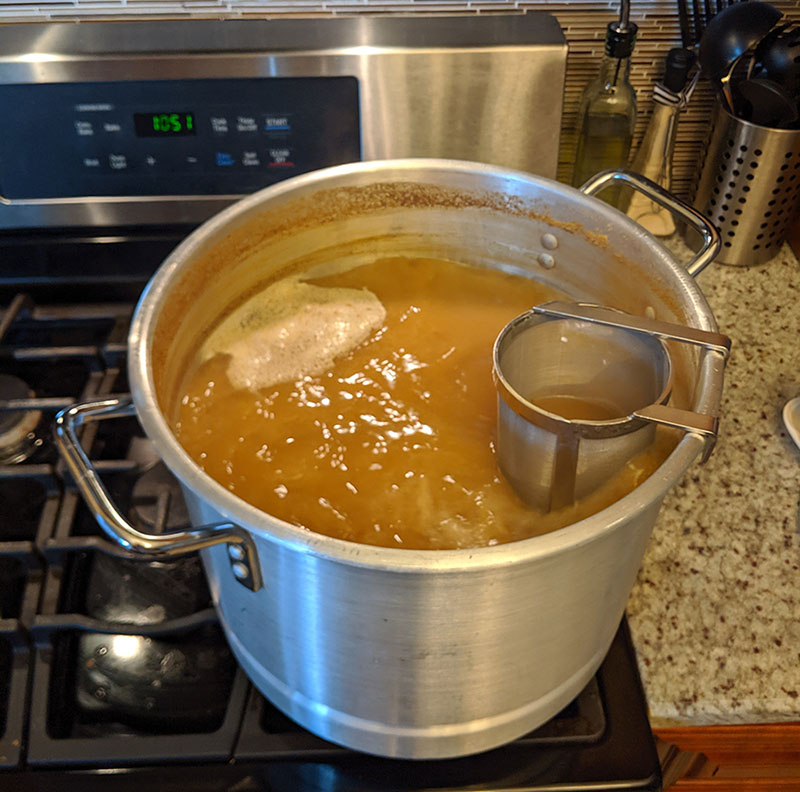 Boil almost done, preparing for whirlpool
Boil almost done, preparing for whirlpoolBoil finished, whirlpool all done, now time to chill down to 68 degrees.
Well, I undershot my OG again. Recipe told me that I should hit 1.081 but I don’t think my efficiency numbers are quite there yet. But 1.078 is not bad at all!
I chilled the wort to 68F and pitched Imperial A24 yeast from a 1L starter. I maintained this temperature for 4 days, before letting it free rise to 70F. I then soft-cold crashed on day 9 to 57F and added second dry hop on day 10. I maintained this temperature for 3 days and cold crashed the beer.
OG: 1.078
FG: 1.025
3 weeks after brewday, my very own Hop Butcher Double Grid clone was ready to drink! This beer turned out beautifully.
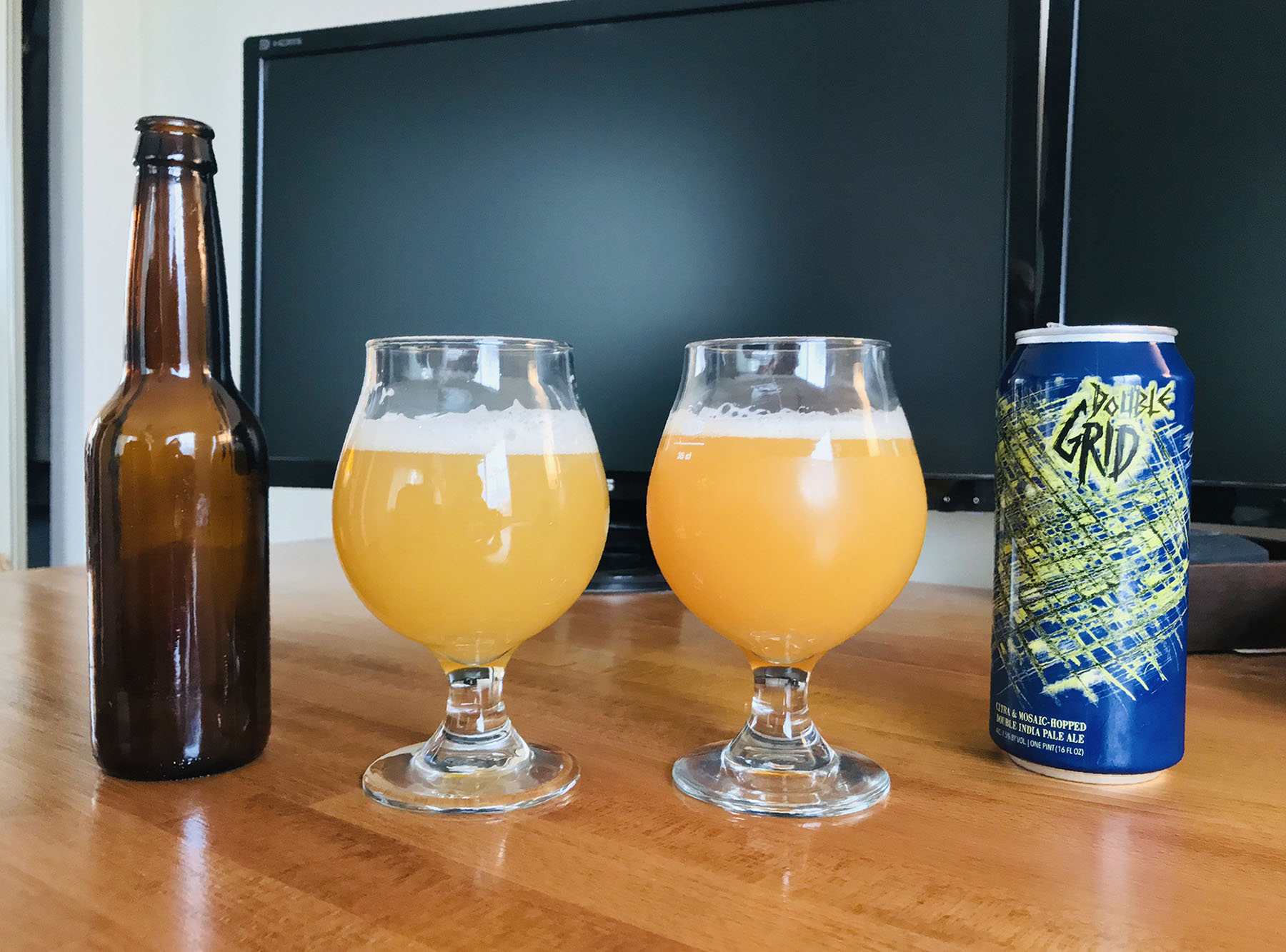 Left: My Hop Butcher clone | Right: Original Double Grid
Left: My Hop Butcher clone | Right: Original Double GridNose: Strong tangerine, lots of peach, tropical.
Flavors: Very tropical, lots of cantaloupe, a little peachy, and a lovely hint of resin. As for the original HB, the same flavors are there, but there is more body and creaminess, as well as Pina Colada-type tropical flavors you get from most of their NEIPA's.
Color: In this picture, my beer is about 3 weeks old, while the can of HB is about 6 weeks. HB is showing some slight oxidation, which is probably why the color is a bit darker. When you get it fresh, it's much more straw-colored like mine. Or maybe the malted oats they use add more color?
Conclusion: I definitely got close and am incredibly happy with this beer. The description on the back of the can is "Fresh Citrus, Light Resin, and Exotic Tropical", check, check, and CHECK! This is probably the best beer I've brewed to date. A dear friend agrees :)
I'm convinced that the yeast is responsible for Pina Colada-type smells and flavors. These flavors are present in all of their beers and is also the aroma that the A24 Dry Hop gave off when I made the yeast starter for this beer. One thing to work on is mastering my fermentation schedule to get these kind of esters. Perhaps pushing this yeast to the height of its range (75F) will help me get more esters. The original Double Grid is also a tad sweeter due to being higher gravity than mine, but that I can easily fix next time with either a slightly higher mash or a tiny bit of lactose.
My friend who works closely with the brewery has confirmed that they do indeed use just a touch of lactose in their Double IPAs. I also saw this as a note someone left on social media when they asked HB if they used any lactose in their beers.
The small dose of lactose (likely 1oz/gallon or less) was added to the next iteration of this beer (to keg) and I can certainly confirm, it adds the final piece of the puzzle.
I chatted with the brewer (Justin) and he confirmed that they "always add at least 3lbs per bbl near finishing", confirming my theory that they add hops very late in the fermentation process.
Personally, I've had very good luck adding half the dry hop at around day 9, and the other half after a cold crash to 50F. I do a closed transfer to a dry hop keg with hops already in there, leave for 2 days, cold crash, then transfer to serving keg using a dip tube.
I'm still working on my fermentation schedule to really get A24 where I want it, but I've had good luck pitching at 68F and letting the yeast free rise to 72F. I've also found that getting fresh, unopened bags of hops in 2oz packages helps my IPA quality overall.
Best of luck to anyone trying this out. Feel free to hit me up and let me know how it went!